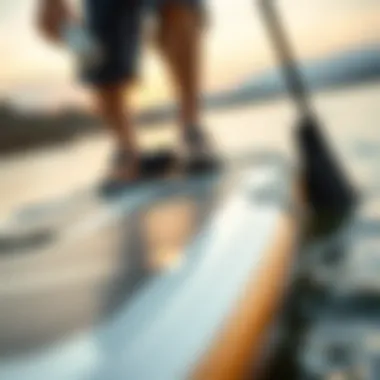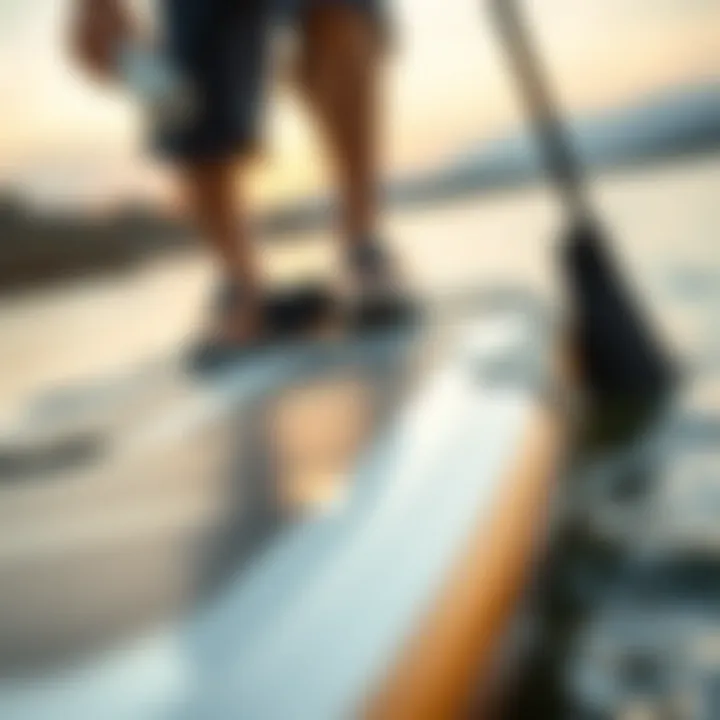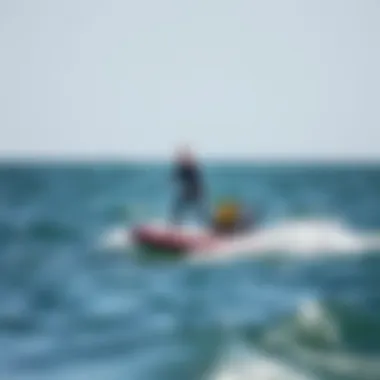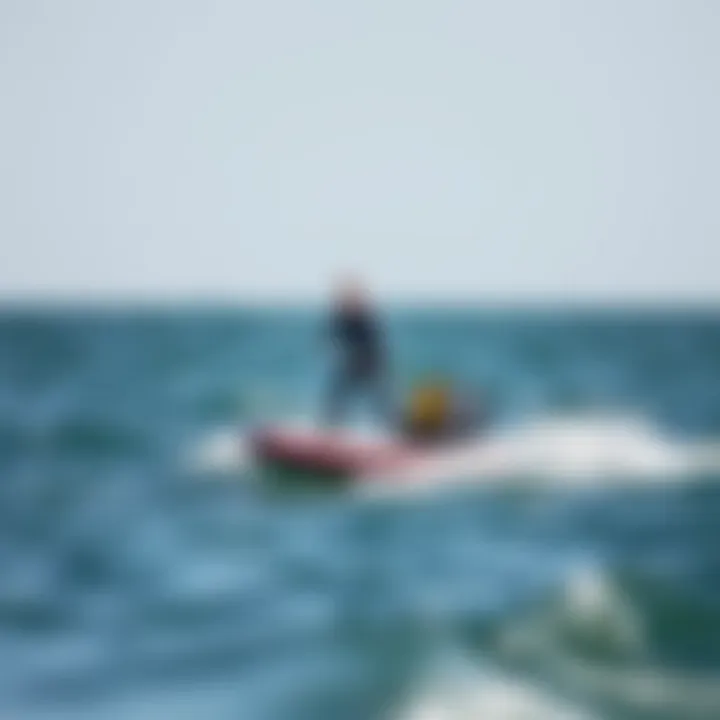Explore the Thrill of Hover Paddle Boarding


Intro
Hover paddle boarding is no ordinary water sport. It combines the thrill of paddle boarding with the exhilarating sensation of flying, allowing riders to glide effortlessly over the water with the aid of an electric propulsion system. For those who have experience with kiteboarding, this innovative concept offers a fresh perspective on familiar skills while enticing newcomers to the world of outdoor sports.
In this guide, we will dissect the various dimensions of hover paddle boarding, focusing on its origins, cutting-edge technology, techniques, and the immersive experience it presents. As we navigate through this guide, kiteboarding enthusiasts and adventure lovers alike will find a treasure trove of insights. Moreover, we will delve into critical equipment choices, safety considerations, and optimal locations for practicing this fantastic sport, bridging the knowledge gap for beginners and seasoned riders. Our goal is to spark envy and excitement for the exhilarating art of hover paddle boarding.
Gear and Equipment
Choosing the right gear is paramount in hover paddle boarding, as the equipment can dramatically influence your performance and enjoyment. Below, we will break down the essential gear for newcomers and delve into more advanced equipment favored by experienced riders.
Essential Kiteboarding Gear for Beginners
For those venturing into the hover paddle boarding arena, the right fundamental equipment is key.
- Electric Paddle Board: This is the centerpiece of your gear. Look for a high-quality electric paddle board, often equipped with a battery-powered motor that provides excellent thrust and control over the water.
- Life Jacket: Safety cannot be overstated. Wearing a life jacket ensures that you stay buoyant even if you take a dive into the drink.
- Wetsuit or Quick-Dry Clothing: Depending on the climate, a wetsuit can protect you from the elements and abrasions, while quick-dry clothing keeps you comfortable if you get splashed.
- Protective Gear: Don’t skip on knee pads or wrist guards. They provide extra safety from falls, especially for beginners finding their balance.
- Basic Paddle: While many electric boards come with built-in propulsion, still having a basic paddle at hand provides the option of traditional paddling if needed.
Advanced Equipment for Experienced Riders
Once you've ridden the waves a few times and feel like a pro, you might want to consider upgrading your setup:
- High-Performance Electric Boards: Riders ready to push their limits can invest in boards with advanced motors and features that allow for higher speeds and agility.
- Customizable Fins: Experimenting with fin shapes and sizes can help you refine your riding style and achieve better performance in different water conditions.
- Advanced Safety Gear: For serious riders, safety packs including a personal flotation device with a built-in safety whistle and emergency beacons can be vital when exploring distant waters.
- Performance Remote: Upgraded remotes offer better control options, including variable speed settings and cruise control, allowing for a customized riding experience.
As you gear up for hover paddle boarding, remember that the right equipment directly contributes to your proficiency and safety, making all the difference between a stellar outing and a frustrating one.
"The thrill you experience on the water is unmatched, but feeling secure with the right gear lets you truly enjoy the ride."
Techniques and Tips
Acquiring the skills needed for hover paddle boarding is integral to making the most out of your adventure.
Basic Riding Techniques for Newbies
When starting out, focus on mastering the fundamentals:
- Balancing: Stand firmly with your feet shoulder-width apart, keeping a slight bend in your knees. This position helps absorb any motions and keeps you steady.
- Starting Off: Begin by using the remote control on your electric board while maintaining a low center of gravity. Once you have gained some speed, ensure you adjust your stance for balance.
- Turning: For smooth turns, lean in the direction you want to go, and shift your weight slightly towards the side of the board.
- Stopping: To stop, gradually decrease speed by easing off on the throttle. Follow this by shifting your weight to the back of the board to slow your forward momentum.
Expert Tricks to Elevate Your Skills
Once you've got the basics down, consider these expert tricks to stand out on the water:
- Carving: Lean into sharp turns, using your body weight to navigate and make your movements more dynamic.
- Jumping: With practice, build up the speed and use small waves or chop to leap off the surface, focusing on your landing technique to prevent falls.
- Waxing: For enhanced grip, applying a suitable wax to the paddle tails can improve control and prevent slips during tight maneuvers.
Whether you’re a novice or looking to enhance your skills further, honing your techniques and mastering new tricks is essential to enjoying the vibrant world of hover paddle boarding. It seamlessly blends the thrill of riding with technical proficiency, ensuring every outing remains a new adventure.
Prolusion to Hover Paddle Boarding
Hover paddle boarding represents a groundbreaking evolution in water sports, seamlessly blending the thrill of paddle boarding with innovative technology. This section introduces the critical aspects of hover paddle boarding, advocating for its importance in the realm of outdoor adventures. As environmental awareness escalates, activities like hover paddle boarding offer a unique fusion of athleticism and conservation. You get to glide above the tranquil waters while minimizing the ecological footprint, which is a win-win for those who cherish nature.
Understanding the Concept
Hover paddle boarding, at its core, relies on hoverboard technology, allowing riders to experience a sensation akin to floating on water. The idea is simple yet transformative. Instead of a traditional board that stays submerged, hover paddle boards utilize a propulsion system that creates a cushion of air, lifting the board above the surface. This shift eliminates drag typically associated with water resistance, granting riders increased speed and maneuverability.
Engaging in hover paddle boarding encourages a fresh perspective on paddling. Enthusiasts can navigate various waterways, offering an exhilarating sense of freedom. Picture yourself skimming across a lake at dawn, the world waking up around you, almost as if you are a part of the very landscape you traverse.
Historical Context
The origins of hover paddle boarding can be traced back to the early 21st century, amid the rise of water sports innovations. While traditional paddle boarding had its roots in ancient Polynesian culture, hover technology took off with advancements in aviation and marine engineering. Initially, it was seen as a novelty, often reserved for tech aficionados eager to try the latest gadgets.
As manufacturers honed their designs and propulsion mechanisms, hover paddle boarding began to gain traction. The first prototypes were clunky and expensive, making them a luxury for most. Over the years, however, companies like Lift Foils and Hoverboard entered the market, focusing on performance and accessibility, opening avenues for both amateurs and professionals.
In 2018, events showcasing hover paddle boarding emerged, marking a turning point in its popularity. Competitions now challenge riders with dynamic courses, merging art with sport. This evolution not only highlights the raw excitement of hover paddle boarding but also emphasizes its growing community, ready to witness and participate in the latest ride innovations.
The Technology Behind Hover Paddle Boards
Understanding the technology behind hover paddle boards is crucial for enthusiasts eager to dive into this thrilling sport. This section illustrates how these boards function, the materials they are made from, and the types of propulsion they use. For anyone looking to optimize their experience or get into hover paddle boarding for the first time, knowledge about the underlying technology is paramount.
Materials and Design
The materials used in hover paddle boards play a significant role in their performance. Many boards are crafted from lightweight composites, like fiberglass and carbon fiber, ensuring both durability and agility on the water. The design often features a streamlined shape to reduce drag, which is especially important for achieving that effortless glide across the surface.
A well-designed hover paddle board incorporates a buoyant core that makes it easier to balance, along with stabilizing fins that help with steering. The aesthetic appeal cannot be overlooked either; vibrant colors and sleek lines often draw in beginners and experienced riders alike, not just for functionality but also for personal expression on water.


When selecting a board, consider how it feels underfoot. A padded surface often provides better grip during maneuvers, while an ergonomic design reduces fatigue enabling longer rides without discomfort.
Mechanisms of Propulsion
Propulsion is the heartbeat of hover paddle boards. While traditional paddle boards rely on human power, hover paddle boards can offer a mix of manual and advanced propulsion techniques. Most commonly, they feature jet propulsion systems or electric motors.
- Jet propulsion systems work by drawing in water and expelling it, creating a thrust that lifts the board off the surface. This method provides a smooth ride, gliding seamlessly over swells and obstacles.
- Electric motors, on the other hand, often rely on battery power, providing a consistent speed and allowing for longer sessions without much physical exertion.
Both systems have their advantages and disadvantages. For instance, jet boards can offer immediate power but may require more maintenance. Electric options offer convenience but need to be charged regularly.
Electric vs. Manual Hover Boards
When it comes to choosing between electric and manual hover paddle boards, personal preference plays a significant role. Electric boards let you ride for hours with little effort, making them ideal for leisurely exploration or for those less inclined towards rigorous paddling.
On the flip side, manual boards still have their charm. They allow for a much greater connection with the water and enhance physical fitness as riders engage more of their muscles. Some seasoned enthusiasts argue that mastering paddle techniques on manual boards enriches the overall experience and skill level.
Here’s a quick comparison to help you decide:
- Electric Hover Boards
- Manual Hover Boards
- Pros:
- Cons:
- Minimal effort required
- Consistent speed
- Longer overall ride time
- Battery dependency
- Heavier due to motors and batteries
- Pros:
- Cons:
- Great for fitness
- Enhanced connection to nature
- Lighter weight allowing for easy transport
- Requires more physical effort
- Can be tiring for longer sessions
Understanding these technological aspects will not only help you choose the right board but will also enrich your experience on the water. Whether you aim for high-performance electric gliding or the hands-on engagement of a manual board, the technology behind hover paddle boarding lays the foundation for whatever adventure awaits.
Essential Gear and Equipment
Hover paddle boarding isn't just an activity; it's an adventure waiting to unfold. Understanding essential gear and equipment is crucial to making your experience both enjoyable and safe. The right tools can elevate your ride, allowing you to explore the beauty of nature from a unique vantage point while also ensuring your safety. Whether you’re a seasoned paddleboarder or a curious beginner, knowing the equipment can make a world of difference.
Selecting the Right Paddle Board
Selecting the ideal paddle board is fundamentally important. Not all boards are created equal, and your experience can vary tremendously based on your choice. Here’s what to consider when making that selection:
- Type of Board: There are different types of hover paddle boards tailored for various water conditions. Some boards are designed for rough waters, while others shine in calm lakes. It’s beneficial to choose one that matches your typical environment.
- Size and Orientation: Board length and width are key factors. Longer boards are generally faster and better for straight tracking, while shorter boards are more manageable and easier to turn. Width can affect stability, so it’s wise to find a balance tailored to your skills.
- Material: Boards are typically made of foam or inflatable materials. Foam boards may provide better performance, but inflatable boards are excellent for portability and storage, making them a preferred choice for many adventurers.
- Weight Capacity: Check the board’s weight limit. It's crucial not to overload it, which can affect performance and safety.
- Design Features: Look out for features such as traction pads, carry handles, and fins. Traction pads assist in maintaining grip, while additional fins can improve maneuverability.
By navigating these factors well, you can find a board that complements your skills and enhances your experience.
Safety Gear Recommendations
Safety isn't just a guideline; it's a necessity. When hover paddle boarding, it’s crucial to equip yourself with the proper safety gear to keep risks at bay. Here are vital equipment suggestions:
- Life Jacket (PFD): Always wear a personal flotation device. Regulations might require it, but your safety is paramount. Look for a Type III PFD, which allows for good mobility while keeping you afloat.
- Helmet: Depending on where you paddle, a helmet might be a prudent choice. It can protect your head from unexpected falls or collisions.
- Wetsuit or Dry Suit: Weather conditions can be unpredictable. Having a wetsuit can help maintain body temperature in cooler waters, while a dry suit keeps you completely dry.
- Leash: A board leash attaches you to the board, which is important if you fall. It reduces the chances of losing your board and helps you avoid drifting away.
- Sun Protection: Don��’t forget about sunscreen! The sun can be relentless on the water, and protecting your skin is essential. Wear UV-protective clothing if you plan a long day on the paddle board.
Techniques and Best Practices
When it comes to hover paddle boarding, mastering specific techniques and best practices is key to enjoying the experience and ensuring safety. These techniques not only bolster your confidence on the water but also enhance performance, allowing you to navigate various conditions and environments effectively. Being well-versed in these methods can make your time on the water more rewarding and exhilarating.
Basic Maneuvers
For newcomers, the foundation lies in understanding and executing basic maneuvers proficiently. These skills might appear simple, but they are extremely crucial in building your confidence and competence on the hover paddle board.
- Getting On and Off the Board: This may seem trivial, yet it can be tricky for first-timers. Always approach the board from the side, avoid destabilizing it, and remember to step lightly.
- Starting and Stopping: To achieve a smooth start, position yourself comfortably in the center of the board, keeping your posture balanced. To stop effectively, shift your weight back slightly and apply gentle pressure to the rear end of the board.
- Steering: Steering involves shifting your weight and using the paddle effectively. Leaning left or right helps to steer in those respective directions. Practice small adjustments to create fluid turns without losing speed.
- Paddling Technique: Use your entire body, not just your arms, while paddling. Place the paddle blade deep in the water with each stroke, rotating your torso to generate power. Efficiency is more important than speed at this stage.
Engaging in regular practice of these basic movements will pay dividends as you progress.
Advanced Techniques
Once you have a solid grasp of the basics, stepping into advanced maneuvers adds a new dimension to your hover paddle boarding adventures. Here are some to consider:
- Turning Techniques: Mastering both the forward and backward pivot turns will help you navigate tighter spaces and changing water conditions gracefully. For a pivot turn, you’ll want to dig your paddle deeply on the side opposite to where you wish to turn and apply your weight accordingly.
- Catching Waves and Swells: Identifying and timing your entry into small waves can immensely enhance your ride. Keep an eye on the water’s rhythm and practice going with the flow to maintain momentum.
- Riding with Speed: Advanced riders often incorporate some dynamic techniques that emphasis efficient paddling stokes, lean angles, and weight distribution to keep the speed up through rough conditions.
- Tricks and Jumps: For those feeling adventurous, incorporating tricks can be a thrilling addition to your repertoire. Start with basic jumps or transitions, gradually building to more complex moves.
Mastering these advanced techniques not only increases your fun quotient but also mitigates risk.
Maximizing Efficiency and Control


Maximizing your efficiency and control during hover paddle boarding involves a combination of understanding your gear and optimizing your techniques. Consider the following:
- Proper Stance: Your stance should be wide and stable. Keeping feet parallel and knees slightly bent provides a lower center of gravity, which translates to better control.
- Weight Distribution: Shift your body weight appropriately when changing directions or in rough waters. Leaning into turns and shifting to the back when descending waves are crucial for maintaining stability.
- Paddle Position: Always keep your paddle within arm’s reach and maintain a slight forward angle. This not only helps in potential rescues but aids in navigating tricky waters.
- Breath Control and Relaxation: Keeping calm and steady not only aids in your focus but also enhances your control over the board. Breathe deep and allow your body to flow with the water.
In essence, understanding these techniques and best practices amplifies your hover paddle boarding experience. A smooth, confident ride can lead to deeper connections with the environment and many rewarding memories on the water.
Safety Considerations
When it comes to hover paddle boarding, safety is not just a suggestion; it’s a vital aspect that can make or break your experience on the water. Understanding safety considerations effectively equips paddlers to handle various situations that might arise while hovering over the waves. These measures ensure the enjoyment of the sport while minimizing risks. This section delves into personal safety measures, environmental factors that can affect your ride, and emergency procedures you should know to navigate challenges effectively.
Personal Safety Measures
Before you even hit the water, making sure you're prepared is crucial. The right gear can significantly lessen the odds of accidents and injuries. Here are a few key considerations:
- Life Jacket: Always wear a properly fitting life jacket or Personal Flotation Device (PFD). Many places require it to be worn at all times, and it can save lives.
- Helmets: If you’re going for a thrill at higher speeds, consider wearing a helmet for added protection.
- Whistle: It's a simple tool, but a whistle can alert others to your location in case you find yourself in a tough spot.
- Wetsuit or Dry Suit: These suits not only keep you warm but also provide some level of buoyancy.
- Leash: A paddle board leash ensures that your board stays close to you in case you fall, reducing the chances of drift.
Staying hydrated and applying sunscreen should not be overlooked either. Sun exposure on the water can lead to serious sunburn, so make those lotions part of your prep before heading out!
Weather and Environmental Factors
Riding on water, you're at the mercy of Mother Nature. Before you launch your hover paddle board, knowing the weather conditions is critical:
- Wind: High winds can make maneuvering difficult and increase your risk of falling. Always check wind speeds before you start your adventure.
- Rain: Sudden downpours can create unsafe conditions, plus they can obscure visibility; better to wait it out.
- Water Temperature: Be aware of how cold the water is. Cold water can sap your body heat quickly, leading to hypothermia, even in summer.
- Currents: Strong currents can be tricky and potentially life-threatening. Familiarize yourself with local currents before paddling out.
- Wildlife: Some areas are home to marine life that may be curious or might provoke a sudden encounter. Always keep a safe distance from wildlife.
Remember: Knowledge is power. The more informed you are about the weather and associated risks, the better decisions you can make for a safe paddling experience.
Emergency Procedures
Even the most cautious paddler might find themselves in an emergency situation. Preparing for the unexpected can significantly increase your chances of staying safe. Here are some key emergency procedures to consider:
- Stay Calm: First and foremost, try to keep a level head. Panic can cloud judgement.
- Signal for Help: Use your whistle, or if in a group, raised hands can signify distress.
- Reboard Safely: If you fall off your board, always attempt to reboard. The board provides buoyancy and something to hold onto.
- Contact Authorities: If you’re in serious trouble, call local authorities or coast guard services. It’s wise to have the emergency numbers saved on your phone.
- Learn Basic First Aid: Basic knowledge of first aid can go a long way. Cuts, scrapes, and stings happen, know how to treat them until proper help arrives.
Safety in hover paddle boarding isn't just about rules; it's about understanding yourself and the environment. Equip yourself with knowledge, prepare for the unexpected, and you’re bound to enjoy this exhilarating sport with peace of mind.
The Experience of Hover Paddle Boarding
Hover paddle boarding offers a uniquely exhilarating experience that goes beyond the typical outdoor sport. For many enthusiasts, navigating glimmering bodies of water on a hover paddle board combines the thrill of traditional paddle boarding with a sense of effortless propulsion. Riders often find themselves captivated not just by the activity itself but also by the connection it fosters with the natural environment around them.
The ability to glide across various water conditions is one of the standout aspects of hover paddle boarding. Whether skimming over calm lakes or tackling choppy ocean waves, the experience is multifaceted, demanding adaptability and skill from the rider. It’s not merely a physical challenge, but a ticket to serenity and adventure all wrapped up in one. The satisfaction derived from conquering differing water elements adds layers of enjoyment and complexity to this outdoor pursuit.
"Hover paddle boarding is about finding the balance between thrill and peace, making it a soul-refreshing endeavor."
Riding on Different Water Conditions
Riding on different water conditions can be both a challenge and a delight for hover paddle boarders. Each body of water presents a new opportunity to hone skills and encounter diverse experiences.
- Calm Lakes - Flat, smooth surfaces allow for easy gliding and are perfect for beginners. Riders can focus on balance and technique without the distraction of waves.
- Rivers with Currents - Entering river waters introduces the element of flow. Learning to navigate currents requires precise control and an understanding of how to utilize the water’s natural movement to one’s advantage.
- Ocean Waves - This is where things get thrilling. Riding ocean swells is a test of endurance and skill. Hover paddle boards can handle small to medium waves, offering an adrenaline rush that is hard to replicate elsewhere.
- Choppy Conditions - Not every ride will be smooth sailing. Choppy waters foster a greater challenge and require more intense concentration, allowing riders to develop their skills further and learn to adapt quickly.
Navigating various conditions also means being aware of safety. Gusty winds, sudden weather changes, and fishing boats can all affect water quality. It's essential to stay informed about local conditions and choose the right equipment to enhance safety and performance.
Connection with Nature
The essence of hover paddle boarding lies in its potential to cultivate a deep connection with nature. As riders traverse serene lakes or crash through ocean surf, they are not just engaging in a sport; they are immersing themselves in the beauty and tranquility of the great outdoors.
- Mindfulness and Reflection - Being out on the open water provides a chance for introspection. Many paddle boarders report a calming effect as they drift along, away from the hustle and bustle of daily life.
- Wildlife Encounters - Hover paddle boarding can often lead to unexpected encounters with wildlife. Swans, otters, and even dolphins might cross paths, providing riders with memorable and enriching experiences.
- Eco-Consciousness - Engaging with nature often raises awareness about environmental preservation. The act of paddling gently through aquatic ecosystems fosters an appreciation for the delicate balance of nature, leading many to become advocates for sustainable practices.
- Social Connections - Sharing experiences on the water can deepen bonds between friends, families, or community members. Navigating scenery together enhances the joy of the experience and creates lasting memories.
Popular Destinations for Hover Paddle Boarding
The charm of hover paddle boarding goes beyond the technology and techniques; it finds its essence in the locations where enthusiasts embark on their aquatic adventures. When searching for an unforgettable experience, the destination plays a pivotal role. Factors like landscape, water conditions, accessibility, and local culture influence not only the ride but also the joy of engaging with a community of like-minded individuals. This section will shed light on some of the top locations and hidden gems around the world that invite paddle boarders, guiding them through environments where they can thrive.
Top Locations Worldwide
Let’s dive into the world’s most acclaimed spots for hover paddle boarding. Here are some standout areas that notably blend breathtaking scenery with the perfect conditions for riding.
- Lake Tahoe, California/Nevada
Known for its crystal-clear waters, Lake Tahoe offers shimmering visibility beneath the surface. Paddle boarding here not only serves the rider's thrill-seeking spirit but also provides unmatched views of surrounding snow-capped mountains. The calm waters create a picturesque setting, making for an ideal spot for both novices and seasoned paddlers. - Santorini, Greece
This island isn’t just about stunning sunsets and whitewashed buildings; the surrounding volcanic waters provide an exotic backdrop for paddle boarders. Exploring hidden coves and gliding alongside cliffs, one can only imagine the stories whispered by the waves. Santorini exemplifies beauty married to the thrill of adventure. - Keys, Florida
Known for the vibrant coral reefs and abundant marine life, the Florida Keys provide not only beautiful scenery but also rich ecosystems to explore. Paddling through the mangroves here offers the chance to encounter dolphins and manatees up close. It’s both an ecological journey and an exhilarating ride.
These destinations prove that hover paddle boarding is not just a sport; it’s a medium through which one can immerse oneself in nature and create lasting memories.
Hidden Gems for Enthusiasts
While the world boasts popular destinations, some less-trodden paths still capture the essence of hover paddle boarding in spectacular ways. These hidden gems may offer quieter experiences and unique landscapes, inviting adventurers to forge their own trails.


- Caye Caulker, Belize
A laid-back island atmosphere envelops Caye Caulker, making it a retreat from the hustle of modern life. The warm, shallow waters offer lazing around as you paddle while becoming acquainted with the vibrant marine life. - British Virgin Islands
With picturesque beaches and warm, tropical waters, the British Virgin Islands are an underappreciated hover paddle boarding haven. Finding secluded spots allows for tranquil adventures away from the crowds. - Eagle Lake in New Hampshire
Just a stone’s throw from bustling cities, this idyllic lake offers serene paddling amidst an uninterrupted natural environment. With paddle board rentals in place and friendly locals, it’s an experience that feels just like home.
These lesser-known locations remind seasoned riders and newcomers alike that there’s beauty in exploration. Each new destination offers potential thrills waiting to be discovered.
"The real voyage of discovery consists not in seeking new landscapes, but in having new eyes." – Marcel Proust
Thus, wherever one chooses to explore, the adventure of hover paddle boarding allows for connection, not only with the water but also with diverse ecosystems and cultures. Whether it’s popular spots teeming with life or hidden gems that provide solitude, the spirit of hover paddle boarding thrives in a variety of locations around the globe.
Building a Community
Building a strong and vibrant community around hover paddle boarding enriches the experience for both newcomers and veterans alike. It creates a platform where shared interests and passions converge, leading to skills enhancement, friendship, and mutual support. No one can deny that the joy of hover paddle boarding seems to multiply when shared with like-minded individuals.
Moreover, immersing oneself in a community allows for collective learning. Engaging with fellow enthusiasts provides opportunities to swap tips, techniques, and personal stories. Insights that can enhance riding experience often come from those who've braved the waters before. When a novice attends a meet-up or local gathering, they quickly grasp that there’s more to hover paddle boarding than just balancing on a board.
The camaraderie is built on various cornerstones: a shared pursuit of adventure, a love for nature, and the thrill of new challenges. It can be a fast track to making friends who understand the ins and outs of paddle boarding; after all, the thrill of catching a wave or zipping along the shore is often best felt with companions.
In essence, the relationships fostered while paddle boarding can be lifelong.
The advantages of forming a community go beyond just immediate gains. It fosters environmental advocacy and passion for water conservation as everyone can rally for a greater cause. Through organized events or clean-up days, the members can connect over shared concerns, raising awareness about issues that affect their favorite paddling spots.
Sharing Knowledge and Experiences
When it comes to sharing knowledge, nothing beats real-world experiences. A key aspect of the hover paddle boarding community is the eagerness of seasoned paddlers to impart wisdom to those just starting out. Learning from their journey—what boards worked best, where the best spots are, or the common pitfalls—provides invaluable lessons that save time and enhance enjoyment.
Whether one attends workshops or simply engages in casual conversations, discussions about technique improvements, gear advancements, or even personal anecdotes contribute a wealth of insight. Often, community members share videos or articles on their social media, encouraging scrutiny and discourse. This openness fosters not only skill acquisition but a sense of belonging among peers, instilling enthusiasm to try new maneuvers or tackle unknown waters.
Some may even organize local meets to focus on specific skills, offering workshops where they dive into the details of maneuvering techniques or equipment handling.
Tips for Effective Knowledge Sharing:
- Host Skill Workshops: Regularly hold events where beginners can learn basics from experienced paddlers.
- Create Online Discussion Forums: Platforms such as Reddit or Facebook groups can help people stay connected.
- Encourage Storytelling: Sharing personal experiences can inspire others to overcome their own challenges.
Finding Local and Online Groups
For those looking to jump into the community without knowing where to start, locating local and online groups is a breeze. Many organizations focus on water sports, and hover paddle boarding is no exception. Websites like MeetUp or local outdoor recreation departments often have listings for events or groups catering to paddleboard enthusiasts.
In the digital sphere, online communities have flourished, allowing individuals to connect regardless of geographical boundaries. Social media platforms like Facebook and Instagram are key players, where dedicated pages or groups provide updates, advice, and networking opportunities.
Strategies to Find Groups:
- Join Local Paddleboarding Clubs: These groups often host regular events and other community-building activities.
- Participate in Social Media: Engaging on platforms fostering paddleboarding messages helps in discovering like-minded paddlers or communities.
- Spend Time on Forums: Sites like Reddit have various threads where paddlers share their experiences and recommendations, making them a great starting point.
Future Trends in Hover Paddle Boarding
Hover paddle boarding is no longer just a passing trend; it's evolving at breakneck speed. The excitement for this water sport extends beyond mere aesthetic appeal or adrenaline rush. It's about harnessing innovation, technology, and creativity, appealing to kiteboarders and outdoor adventurers alike. This section explores how advancements are shaping the future of hover paddle boarding, making it a more accessible and enjoyable activity.
Innovative Developments
The innovations in hover paddle boarding mirror broader trends in water sports and technology, underscoring not just performance but user experience. A few key developments include:
- Advanced Battery Technologies: Recent strides in battery efficiency mean longer rides without the pesky worry of running out of juice mid-sesh. Efforts are underway to improve weight-to-power ratios, leading to lighter, more agile boards.
- Hydrodynamic Designs: New shapes and material blends allow boards to glide more effortlessly on water, enhancing overall maneuverability. Research in fluid dynamics has led manufacturers to create boards that slice through water more effectively. This not only boosts speed but also makes navigation smoother in choppy conditions.
- Smart Features: Imagine a paddle board equipped with sensors that provide real-time data on speed, distance, or even wave height. Features like GPS tracking, fitness metrics, and interactive apps are becoming part of the experience. These elements can make hover paddle boarding more engaging, especially for tech-savvy users.
“Innovation isn’t just about technology; it’s about rethinking how you engage with the environment while enjoying it.”
These advancements represent a shift in focus towards a more personalized experience, where riders can leverage technology to enhance their adventures.
Impact of Technology on the Sport
Technology’s role in hover paddle boarding is vital, as it not only influences equipment design but also enhances rider interaction with their environment. Consider the following impacts:
- Enhanced Safety Features: As the sport grows, safety cannot take a backseat. Innovations such as automatic stabilization systems help paddlers maintain balance, reducing the chance of accidents. Additionally, built-in emergency locators can be a game-changer, ensuring help is always within reach when out on the water.
- Community Engagement: Digital platforms have significantly broadened the hover paddle boarding community. Many enthusiasts share experiences, tips, and results through social media and dedicated forums. This connectivity allows riders to feel part of something bigger, encouraging participation and knowledge sharing.
- Sustainability Efforts: Manufacturers increasingly embrace eco-friendly materials and processes. Since hover paddle boarding thrives in natural settings, using sustainable and recyclable materials is essential. Future trends will likely see an even greater commitment to protecting marine environments while enjoying them.
As technology continues to evolve, expect hover paddle boarding to become not just an activity but a holistic lifestyle, driven by community engagement and sustainable practices. The future looks promising, and the innovations ahead may very well redefine what it means to be a hover paddle boarder.
End
In closing, the world of hover paddle boarding emerges not just as a sport but a unique lifestyle and community. This guide has explored various facets—from the technological marvels behind hover boards to the safety measures every rider must consider. Understanding the nuances of this vibrant sport is essential for both novices and seasoned enthusiasts. With its roots grounded in water sports and an exciting twist of technological sophistication, hover paddle boarding offers an experience that unites adventure with innovation.
Recapping the Key Points
- Technology and Design: Hover paddle boards utilize cutting-edge materials that provide both durability and lighter weight. Strong composites are essential for performance without sacrificing agility.
- Safety: Riders must always wear appropriate safety gear, like life jackets and helmets, and should stay informed about environmental conditions. This is crucial for ensuring safety while navigating different water terrains.
- Experience: Engaging in hover paddle boarding allows individuals to connect with nature in a refreshing way, often experiencing a profound sense of peace amid the waves. The thrill of gliding across water is unparalleled.
- Community Connection: Leveraging online platforms and local groups fosters knowledge sharing and camaraderie among riders, enhancing both individual skills and collective excitement about the sport.
Encouraging Exploration and Engagement
Hover paddle boarding is more than mere recreation; it is an invitation to explore the marvelous outdoors and connect with like-minded individuals. As technology evolves, it remains vital to stay aware of new developments and trends. Engaging with online platforms, blogs, and forums enables vast avenues for experiential learning and community involvement.
Investing time to understand the equipment, safety considerations, and the local landscape can lead to richer excursions. For those keen on adding a dash of thrill to their lives, exploring the world of hover paddle boarding could be a transformative decision. Imagine gliding above water, incorporating both creativity and skill—what could be more liberating?
It's time to step on board and ride the waves of excitement that hover paddle boarding brings into adventure sports.















